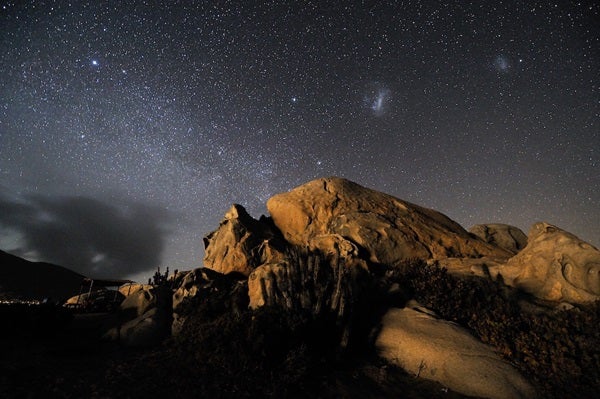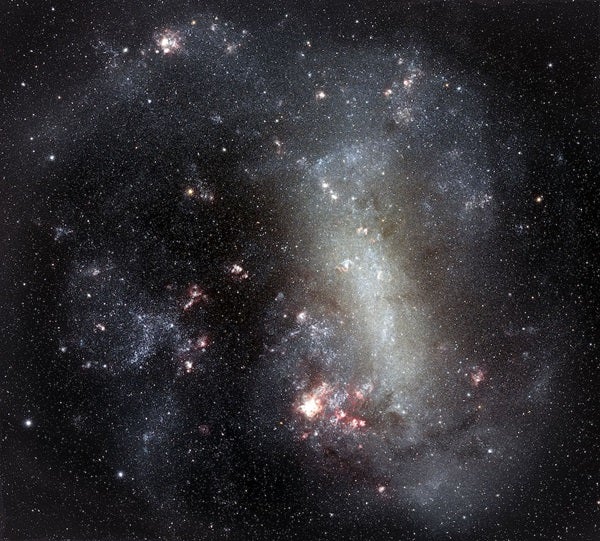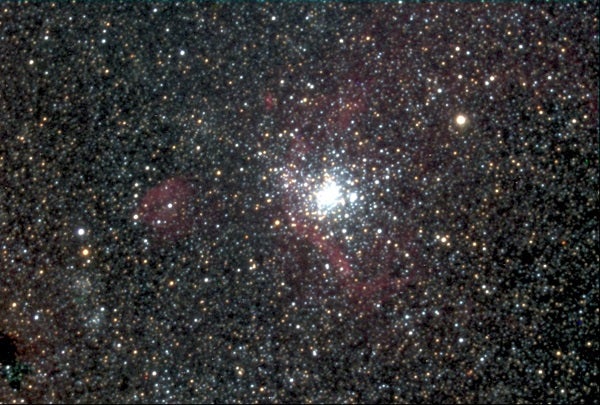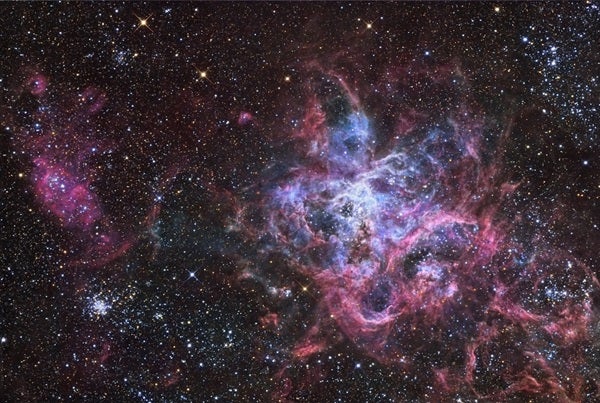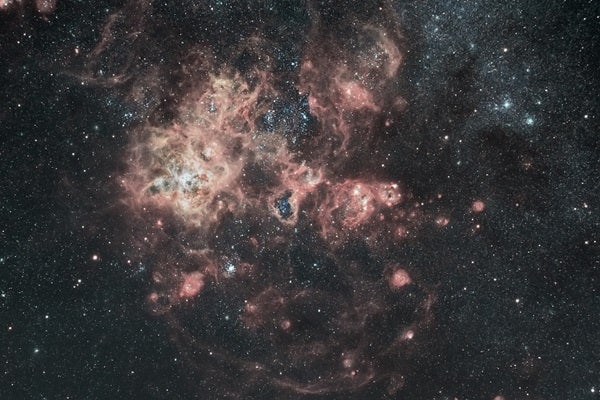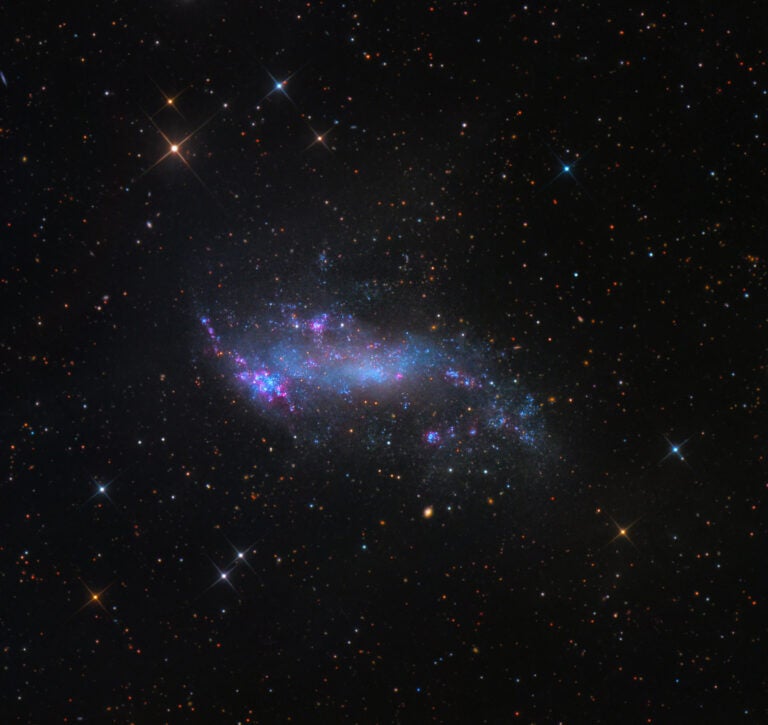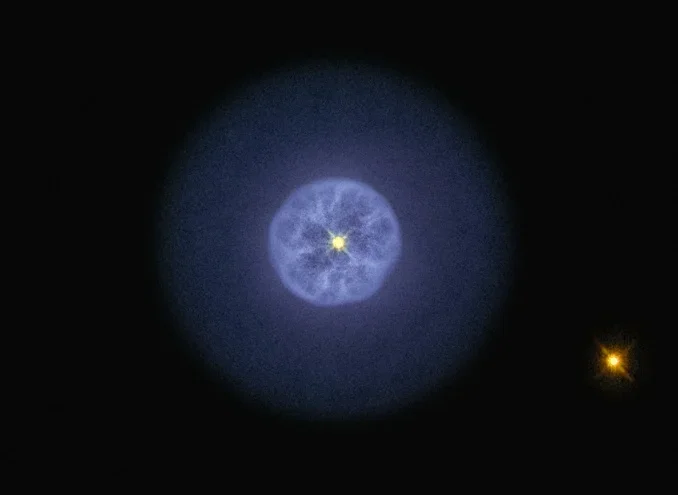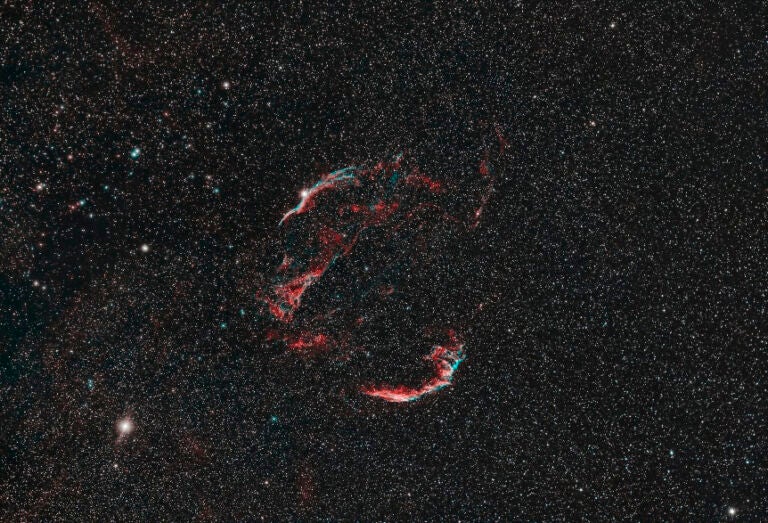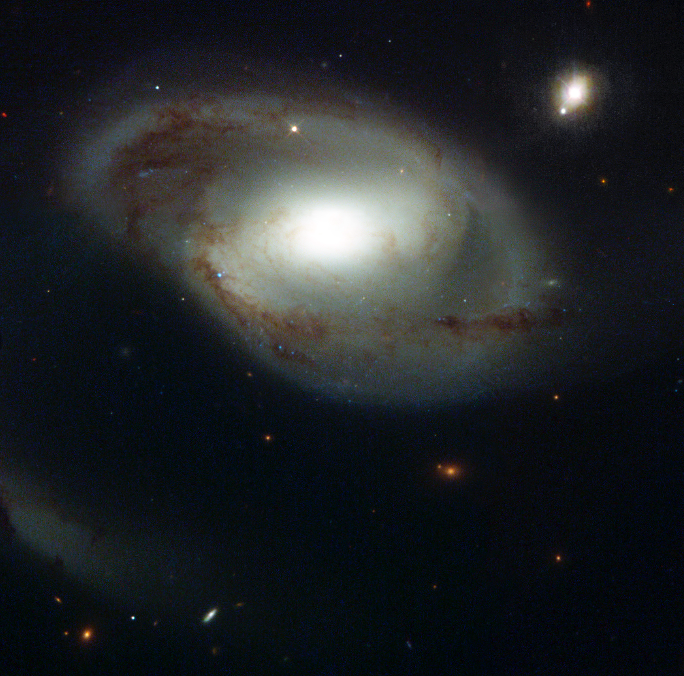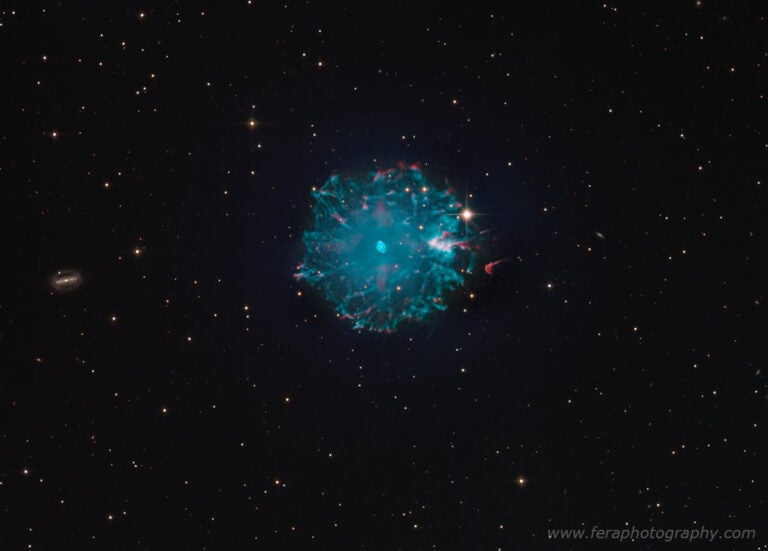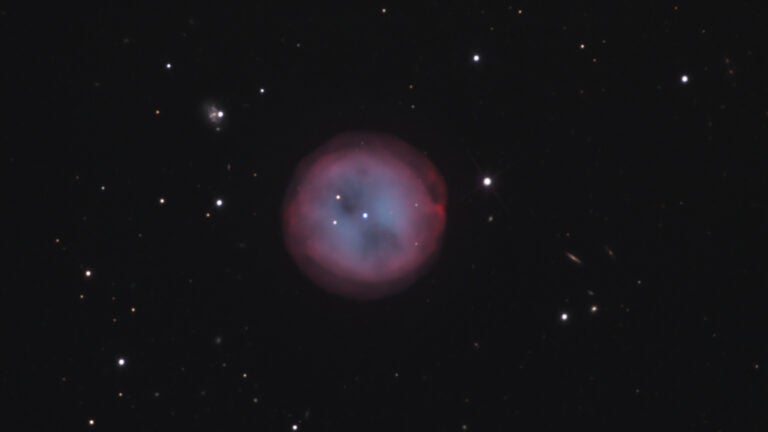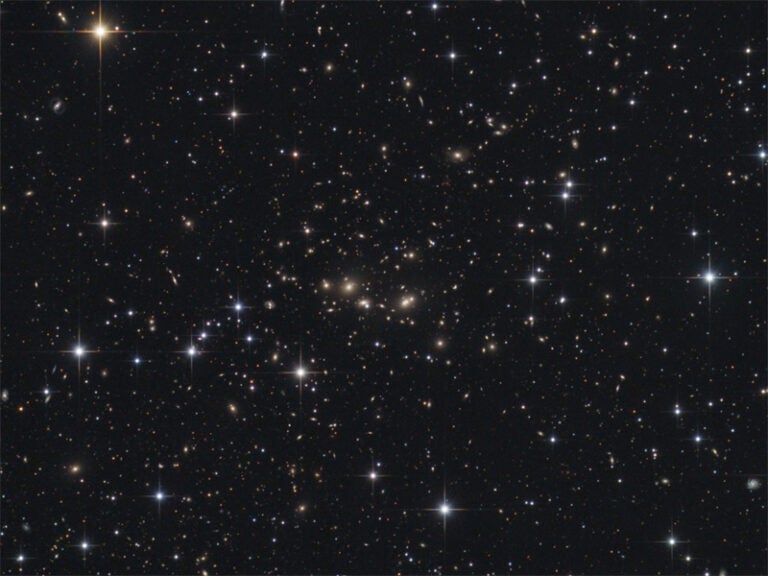The Large Magellanic Cloud (LMC) is the southern sky’s greatest celestial wonder. It is the Milky Way’s biggest satellite galaxy, just 160,000 light-years distant, and the fourth-largest member of the Local Group. The LMC lies primarily in the far-southern constellation Dorado the Swordfish, but some of it spills over into the neighboring constellation Mensa the Table Mountain, which lies even farther south. To see even part of the LMC, you must be south of latitude 20° north. And for it to appear even halfway up in the sky at its highest, you’ll need to be at latitude 25° south.
With a magnitude of 0.4, the LMC is an easy naked-eye object even from mildly light-polluted areas, so let’s start by looking at it as a whole. Under a dark sky, use just your eyes to look at the LMC. You’ll see that its brightest region is a bar roughly 5° long by 1° wide. That makes it 10 times as long and twice as wide as the Full Moon. The surrounding region is a fainter, oval haze measuring an amazing 6° by 4°. And you can extend the LMC’s boundary beyond this — just use binoculars or a low-power rich-field telescope.
Through a 6-inch or larger scope and an eyepiece that gives a magnification around 200x, slowly scan back and forth across the LMC’s face. You’ll see lots of star clusters and nebulae in the field of view. If you screw a nebula filter (perhaps an Oxygen-III) into your eyepiece, it will help you distinguish the nebulae from the clusters. The filter won’t make the nebulae brighter; rather, it will block most of the light from stars so the clusters won’t be as apparent.
Deep-sky objects abound in the LMC. It contains no less than 114 NGC objects. Here are a few that I’ve enjoyed looking at each time I’ve had the chance.
Crank up the power
Let’s start this list with NGC 1714. This tiny emission nebula (it measures only 1.2′ across) sits on the western edge of the LMC just over 6° southwest of magnitude 3.8 Beta (β) Doradus. Although it is small, its high surface brightness lets you crank up the magnification for a detailed view. Through an 8-inch scope, you’ll see a round glow with a bright northern rim. A magnitude 6.3 star, GSC 8889:215, lies just 8″ west. And as a bonus, slightly fainter NGC 1715 — another emission nebula — lies 1′ north of NGC 1714.
Our next target, open cluster NGC 1755, also lies on the western edge of the LMC’s bar, slightly south of NGC 1714. It glows at magnitude 9.9 and is 2.6′ across. An 8-inch telescope at 100x reveals 20 stars of magnitudes 13 and 14 packed into an area 2′ wide. You’ll also see a strong background glow from lots of stars too faint for your scope to resolve. A much fainter open cluster, NGC 1749, which glows at magnitude 13.5, lies 2′ to the northwest. You’ll need a lot more than 8 inches of aperture to spot it.
Our next target — or should I say group of targets, four emission nebulae — lies about 2° north of NGC 1755. They’re close together, too, in an area less than 0.3° across. The one you’ll notice first is NGC 1763. It appears as a clumpy haze that measures 5′ by 3′, surrounded by a grouping of stars that looks like an open cluster — but it’s not. Just 7′ south, you’ll find NGC 1760. Move 7′ east-southeast from NGC 1763, and you’ll encounter NGC 1769. Finally, NGC 1773 lies 9′ east-northeast of NGC 1763.
Because the LMC is a galaxy, we expect it to contain the full range of deep-sky objects. (OK, except for galaxies.) Seek out NGC 1835, also along the western part of the bar, and you’ll be looking at a globular cluster, one of only two on this list. It glows at magnitude 10.1 and measures 1.2′ across.
NGC 1835 looks round at low power, but crank up the magnification and you’ll see faint extensions to the east and west that double its length. Two faint open clusters, magnitude 12.5 NGC 1828 and magnitude 12.6 NGC 1830, lie 6′ to the northwest.
Next up is the massive open cluster NGC 1850. In fact, astronomers classify this as a super star cluster, one that is brighter and more massive than normal open clusters, which also may eventually become a globular cluster. You’ll find NGC 1850 in the northeastern part of the LMC’s bar, with an apparent diameter of 3.4′. It’s so bright that it glows at magnitude 9.0.
Point an 8-inch scope at this cluster, and you’ll see roughly 50 stars glowing at magnitudes 13 and 14. The prominent clump of stars on NGC 1850’s western edge, NGC 1850A, actually makes this object a double cluster.
Our next object, NGC 1866, is another open cluster that lies in the northern reaches of the LMC. I think this object will amaze you through a 12-inch or larger telescope. It glows at magnitude 9.7 and spans 4.5′.
The easiest way to find it is to start at Beta Doradus and sweep 3.7° south-southwest. The brightest stars in this cluster glow at 15th magnitude, so you’ll need a large aperture to reveal them. Through a 14-inch scope with an eyepiece that yields a magnification of 300x or higher, you’ll see hundreds of stars.
Moving to the north central region of the LMC, you’ll come across yet another clump of four emission nebulae, but they’re packed even closer together than the previous group I described. Indeed, NGC 1962, NGC 1965, NGC 1966, and NGC 1970 fit into a region only 5′ across.
Through an 8-inch telescope at low power, NGC 1962 will be the most apparent, although even it appears circular and featureless. Then crank up the magnification above 200x and examine the region north and east of NGC 1962. You’ll see the other three nebulae arcing along its rim.
Our next target is the other globular on this list, NGC 2019. It lies along the LMC’s bar just to the east of its center. It’s not bright, glowing at magnitude 10.9. It’s also pretty small, measuring a scant 1′ in diameter. The reason you’ll see it, however, is because of its small, bright central region. NGC 2019 has a collapsed core — meaning its stars are unusually concentrated at its center — a phenomenon that’s happened in several other globular clusters in the Magellanic Clouds.
An 8-inch telescope will reveal the core easily. It actually appears lumpy rather than starlike. Crank the power past 200x, and you should be able to spot NGC 2019’s irregular outer boundary. If you can double your aperture to 16 inches, individual stars will appear.
Our next object — the Tarantula Nebula — is the standout on this list and the only one with a common name. It has two others: 30 Doradus and the True Lover’s Knot. It’s also often called NGC 2070, but that specifically refers to the super star cluster at the nebula’s center.
Because it lies so far south, most northern observers haven’t experienced this celestial wonder. And although it is some 160,000 light-years away, the Tarantula Nebula looks incredible even through medium-sized telescopes. Although its apparent diameter is 40′ by 25′, its true diameter is slightly more than 1,800 light-years. If it were as close as the Orion Nebula (M42), it would span over 60° — one-third of the entire sky.
The brightest star cluster in the Tarantula Nebula and the most remarkable star-forming region anywhere is R136, whose designation comes from the Radcliffe Observatory Magellanic Clouds Catalogue, published in 1960. This cluster alone glows at magnitude 9.5. The 75 spectral class O stars at its heart are among the most massive, brightest, and hottest known. Its total mass is more than 450,000 times that of the Sun. This cluster produces the ultraviolet radiation that causes the Tarantula Nebula to shine.
Observers with even a 4-inch telescope will see a dense bar running north to south through the nebula’s center. Then look for the loops and filaments within the gas. The longest filament begins near the cluster’s center and extends 7′ to the south. It then heads eastward and curves an equal distance to the north. R136 is easy to spot as a 1′-wide region, and if you crank up the magnification, you’ll be able to pick out several dozen of its bright stars.
Look also for the two dark bays, one slightly darker than the other, just east of R136. Both these regions have nebulous filaments encroaching on their borders. Their appearance led English astronomer William Henry Smyth to describe this nebula as the True Lover’s Knot. Some accounts say that 16th-century Dutch sailors tied similar knots to remind them of lovers they’d left behind.
Once you have found the Tarantula Nebula, head just 0.3° east to open cluster NGC 2100. It glows at magnitude 9.6 and measures 2.8′ across. If you use an 8-inch telescope and a magnification around 200x, the first feature you’ll see will be the compact core. You’ll need higher power (and probably a bigger scope) to resolve any of its stars. Just surrounding the core, however, you should see about two dozen stars.
The final object on this tour is open cluster NGC 2214. It has a diameter of 3.6′ and a magnitude of 10.9. You’ll find it 4.5° east-northeast of the LMC’s center. For a better marker, look 0.7° north-northeast of magnitude 5.1 Nu (ν) Doradus.
A 4-inch telescope will show NGC 2214 as a faint haze. This is a tough nut to crack, though, even through a 12-inch scope. Crank the magnification to 250x or beyond and you’ll just start to resolve some of the cluster’s stars at its edge.
Observe at your own pace
When you train a telescope on the Large Magellanic Cloud, don’t rush to see everything. Many of the objects I’ve just described — the Tarantula Nebula being the exception — take a bit of coaxing at the eyepiece. Believe me, your patience will be rewarded.

